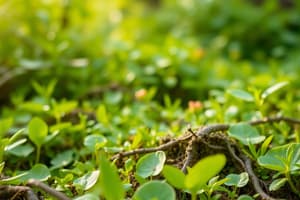Podcast
Questions and Answers
What is the difference between biotic and abiotic factors?
What is the difference between biotic and abiotic factors?
Biotic factors are living factors in an ecosystem, while abiotic factors are nonliving factors in an ecosystem.
What are the levels of biological organization?
What are the levels of biological organization?
- Organism 2. Population 3. Community 4. Ecosystem 5. Biosphere 6. Biome
What is the difference between an organism's habitat and its niche?
What is the difference between an organism's habitat and its niche?
An organism's niche is its way of life, while a habitat is where an organism lives.
How does energy flow through an ecosystem?
How does energy flow through an ecosystem?
How are food chains and food webs related?
How are food chains and food webs related?
What is a limiting factor?
What is a limiting factor?
What are two examples of a limiting factor?
What are two examples of a limiting factor?
What is the difference between primary and secondary succession?
What is the difference between primary and secondary succession?
What is meant by the range of tolerance?
What is meant by the range of tolerance?
What is ecological succession?
What is ecological succession?
What does Lupin do?
What does Lupin do?
What is unique about the cones of pine trees?
What is unique about the cones of pine trees?
What are autotrophs?
What are autotrophs?
What are heterotrophs?
What are heterotrophs?
What are herbivores?
What are herbivores?
What are omnivores?
What are omnivores?
What are carnivores?
What are carnivores?
What are detritivores?
What are detritivores?
What is the significance of energy flow in an ecosystem?
What is the significance of energy flow in an ecosystem?
What is a food chain?
What is a food chain?
What is a food web?
What is a food web?
What is a tertiary consumer?
What is a tertiary consumer?
What is a secondary consumer?
What is a secondary consumer?
What is a primary consumer?
What is a primary consumer?
What are producers?
What are producers?
What is an ecological pyramid?
What is an ecological pyramid?
What defines an ecosystem?
What defines an ecosystem?
What is an organism?
What is an organism?
What defines a species?
What defines a species?
What is a population?
What is a population?
What is a community in ecological terms?
What is a community in ecological terms?
What is a niche in ecology?
What is a niche in ecology?
What is a habitat?
What is a habitat?
What is a predator?
What is a predator?
Flashcards are hidden until you start studying
Study Notes
Ecosystem Fundamentals
- Biotic vs. Abiotic Factors: Biotic factors are living, such as plants and animals, while abiotic factors are nonliving, including sunlight and temperature.
- Levels of Biological Organization: Ranges from individual organisms to populations, communities, ecosystems, biomes, and the biosphere.
Ecological Roles and Energy Flow
- Habitat vs. Niche: Habitat refers to the physical location of an organism, while niche encompasses its role in the ecosystem and interactions with living and nonliving elements.
- Energy Flow: Starts with solar energy captured by autotrophs, then transferred through various consumer levels, eventually recycled by detritivores.
Food Relationships
- Food Chains vs. Food Webs: Food chains outline direct energy transfer, whereas food webs illustrate complex interconnections between multiple food chains.
- Trophic Levels: Each level represents a step in the food chain: producers at the base, followed by primary consumers (herbivores), secondary consumers (carnivores/omnivores), and tertiary consumers (top predators).
Succession and Limiting Factors
- Limiting Factors: Conditions that limit the growth, reproduction, and distribution of organisms, such as sunlight and temperature.
- Primary vs. Secondary Succession: Primary succession occurs in lifeless areas where soil is created, while secondary succession happens in areas where a disturbance has cleared a community but left the soil intact.
Organism Roles in Ecosystems
- Autotrophs: Organisms that synthesize their own food using sunlight (e.g., plants).
- Heterotrophs: Organisms that obtain energy by consuming other living things; includes herbivores, carnivores, and omnivores.
- Detritivores: Consume decomposing organic matter, returning essential nutrients to the ecosystem.
Ecological Structures
- Ecological Pyramid: Illustrates trophic levels from producers at the bottom to apex predators at the top, showing energy flow and biomass distribution.
- Species Definition: A group of organisms capable of interbreeding and producing fertile offspring, sharing similar genetic traits.
Additional Concepts
- Ecological Succession: The process where communities evolve due to changing environmental conditions, replacing existing communities.
- Lupins: A plant species with nitrogen-fixing bacteria that enrich the soil.
- Pine Trees: Produce cones that require fire for seed release, adapted for survival in fire-prone environments.
Studying That Suits You
Use AI to generate personalized quizzes and flashcards to suit your learning preferences.




